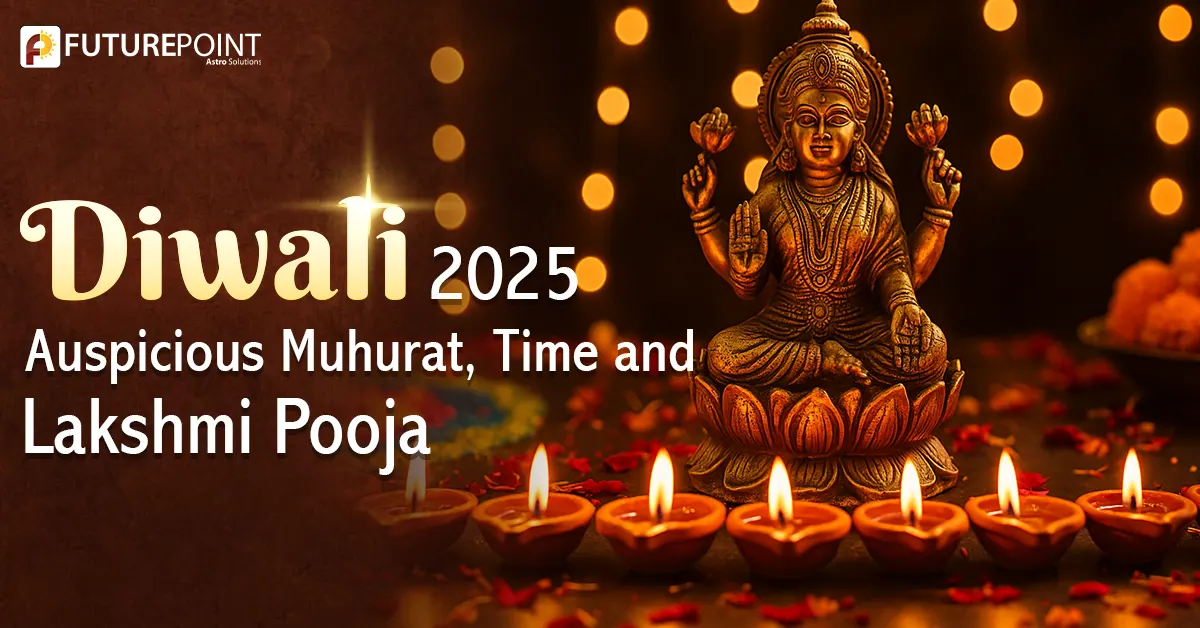Diwali 2025: Auspicious Mahurat, Time and Lakshmi Pooja
By: Future Point | 24-Sep-2025
Views : 5652
Diwali is one of the most awaited & immensely auspicious Hindu festivals celebrated across India each year. This is a festival of lights and celebrations are carried out throughout the country by bursting crackers, distributing sweets to near and dear ones and dressing up in new & festive attire. But not all in the current generation know the purpose of celebrating Diwali. So, in a short note, let us understand for the benefit of our readers as to why is Diwali Celebrated?
Diwali Celebration
As per the Hindu Lunar calendar, Diwali is celebrated on the ‘Amavasya’ (New Moon) of the Kartik month. Diwali in 2025 will be celebrated on 20th October 2025. Diwali as a festival is celebrated across the country with much significance; culturally and traditionally. It also has many spiritual significances such as victory of light over darkness or good over evil and knowledge over ignorance etc. The primary reason for celebrating Diwali is as follows:
Diwali is celebrated to commemorate the victory of Lord Rama over the demon king Ravana. After slaying Ravana, the King of Lanka, and completing His 14 years of exile, Lord Rama returned to Ayodhya along with his wife, Sita, and brother, Lakshmana. The day when Lord Rama entered Ayodhya was Amavasya or New Moon day in the month of Kartik.
The people of Ayodhya welcomed Lord Rama by lighting diyas or lamps. As time passed, the tradition of bursting crackers & fireworks also got added to the celebration. Diwali is widely referred to as the ‘Festival of Lights’ and is celebrated with an unparalleled festive spirit & fervour.
Also Read: Bhai Dooj 2025: Date, Muhurat, Significance, and Rituals Explained
The Important Days During Diwali
The celebration of Diwali lasts for Five days. The celebrations start with a festival called “Dhanteras”. Where "Dhan" means wealth and "Teras" refers to the 13th day of the lunar fortnight (Trayodashi) as per the Hindu calendar. This day is dedicated to celebrating prosperity. Goddess Lakshmi is welcomed to one’s home and gold is purchased as a mark of welcoming the goddess.
The 2nd day or the day of Chaturdashi which is the 14th day of the lunar fortnight is celebrated as “Choti Diwali”.
The 3rd day or the day of Amavasya which is the darkest day of the month is the most significant day of the Diwali festival across India. Goddess Lakshmi is worshipped on this day too, with a special puja performed during the evening.
The 4th day is celebrated as “Govardhan Puja”. This is the “Prathama Tithi”- the first date of the new fortnight.
And finally, the last of the 5 days is celebrated on “Dwitiya Tithi” (second day of the lunar fortnight) as “Bhai Dooj”. It's dedicated to celebrating the sacred bond of love & affection between brothers & sisters just like the festival of Raksha Bandhan.
Diwali 2025 Date and Muhurat Timings
Diwali : Monday, October 20th, 2025
Muhurat Timings: 07:08 PM 08:18 PM
Govardhan Puja : Wednesday, October 22nd, 2025
Muhurat Timings: 06:26 AM to 08:42 AM
Bhai Dooj : Thursday, October 23rd, 2025
Muhurat Timings: 01:13 PM to 03:28 PM
Laxmi Ganesh Puja Preparation
All Hindu festivals are celebrated by decorating your home, and Diwali is no exception. Interestingly, the offices are also decorated during Diwali. The common flowers used during Diwali are Marigold along with Ashoka, Mango and Banana leaves. The decoration is done as part of a preparation for the Laxmi Ganesh which is performed in the evening.
People place a “Manglik Kalash” covered with unpeeled coconut on both the ends of the entrance of their homes.
Many people maintain a raised platform in the form of a “Puja Chowki” where they place the idols of Goddess Laxmi and Lord Ganesh.
As part of the Laxmi Ganesh Puja, various stotras and hymns are chanted to please Goddess Laxmi and Lord Ganesh. Lord Ganesh is also worshipped to ward off obstacles from life.
Thus, Diwali is celebrated with great festive spirit and reverence by offering prayers to Goddess Laxmi and Lord Ganesh. It is believed that when Goddess Laxmi and Lord Ganesh are offered pooja on this day, the coming year gets filled with prosperity and one overcomes obstacles in the path to success.
Also Read: Govardhan Puja 2025: Significance, Rituals, and How to Celebrate
Conclusion
Diwali is a festival that binds the society and brings prosperity in the lives of all. Every family should perform a Laxmi Ganesh Puja on the eve of Diwali at a “Shubh Muhurat” (auspicious timing) and while following the rules & rituals that are [prescribed in the Holy Hindu scriptures.
Future Point offers you an incredible opportunity to book the Laxmi Ganesh Puja for Diwali to be performed in your name. This puja which is popularly known as Diwali Puja, is performed on the behalf of you & your family by a highly learned Brahmin Priest, strictly in accordance with all the Vedic rituals as prescribed in the scriptures.
So, what are you waiting for?
The festive season is just around the corner and you must make the best use of this sacred yearly occasion to receive the divine blessings of Goddess Laxmi and Lord Ganesh.
Book the Laxmi Ganesh Puja from Future Point and get the divine blessings that would bring success & prosperity in your life and ward off all negative influences that cause hurdles & obstacles.
Future Point wishes you & your family- A Very Happy & Prosperous Diwali 2025!!